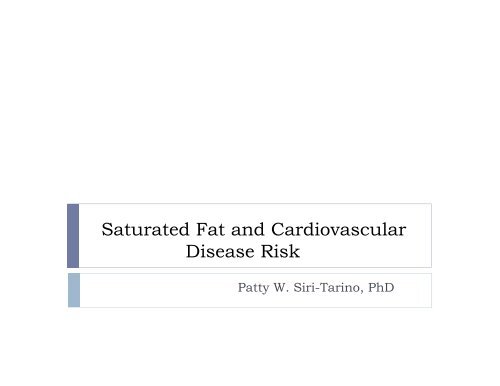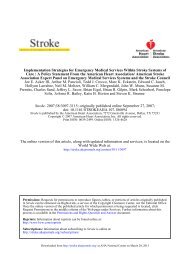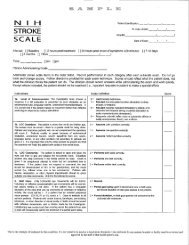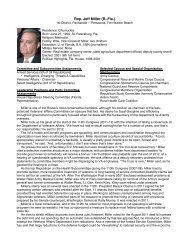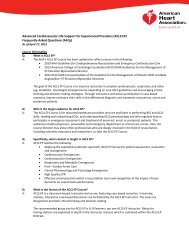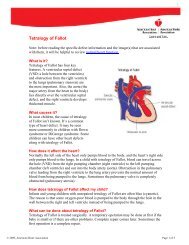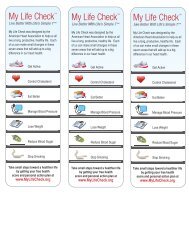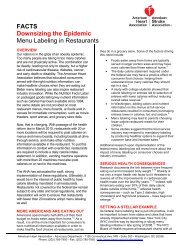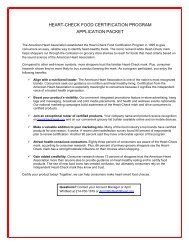Astrup A et al. Am J Clin - American Heart Association
Astrup A et al. Am J Clin - American Heart Association
Astrup A et al. Am J Clin - American Heart Association
Create successful ePaper yourself
Turn your PDF publications into a flip-book with our unique Google optimized e-Paper software.
Saturated Fat and Cardiovascular<br />
Disease Risk<br />
Patty W. Siri-Tarino, PhD
Di<strong>et</strong>ary Saturated Fat and CVD Model<br />
Di<strong>et</strong>ary<br />
Saturated Fat<br />
LDL Cholesterol<br />
Other CVD risk<br />
factors<br />
CVD
CHD Mort<strong>al</strong>ity is Correlated with Plasma<br />
Cholesterol Levels<br />
18<br />
16<br />
Six Year CHD Mort<strong>al</strong>ity from MRFIT<br />
CHD<br />
Death<br />
Rate<br />
per<br />
1000<br />
14<br />
12<br />
10<br />
8<br />
6<br />
4<br />
2<br />
0<br />
Desirable<br />
Borderline<br />
High<br />
HIGH<br />
140 160 180 200 220 240 260 280 300<br />
Plasma Cholesterol (mg/dl)<br />
LaRosa <strong>et</strong> <strong>al</strong>, 1990
Saturated Fat Replacement Scenarios<br />
Replacement<br />
Nutrient<br />
TC LDL-C HDL-C TG TC/HD<br />
L-C<br />
PUFA ≈ <br />
MUFA ≈ <br />
CHO ≈<br />
Mensink RP and Katan MB. Arterio Thromb 1992, 12:911-919; Mensink RP <strong>et</strong> <strong>al</strong>. <strong>Am</strong> J <strong>Clin</strong> Nutr 2003, 77:1146-55.
Atherogenic Dyslipidemia<br />
Obesity<br />
Insulin Resistance<br />
Di<strong>et</strong>ary Carbohydrate<br />
- Elevated triglyceride concentrations<br />
- Reduced HDL cholesterol concentration<br />
- Sm<strong>al</strong>l and dense LDL particles<br />
Krauss RM and Siri PW. Endocrin M<strong>et</strong>ab <strong>Clin</strong> N <strong>Am</strong>er 2004; 33:405-415
LDL cholesterol is comprised of different<br />
subclasses with differing CVD risk<br />
Large<br />
1<br />
Medium<br />
Sm<strong>al</strong>l<br />
2<br />
3<br />
4<br />
Increased CVD risk<br />
Reduced clearance<br />
Greater entry into artery<br />
Greater r<strong>et</strong>ention<br />
Faster oxidation<br />
Distribution of subclasses varies widely among individu<strong>al</strong>s and is<br />
independent of tot<strong>al</strong> LDL cholesterol<br />
Berneis and Krauss, JLR 43:1155, 2002
Saturated fat increases large and medium, but<br />
not sm<strong>al</strong>l, LDL particles<br />
Krauss RM, <strong>et</strong> <strong>al</strong>. 2006; 83: 1025-1031; Siri-Tarino P W <strong>et</strong> <strong>al</strong>. <strong>Am</strong> J <strong>Clin</strong> Nutr 2010;91:502-509
Reduced Tot<strong>al</strong>/HDL Cholesterol with Both<br />
Carbohydrate Reduction and Weight Loss<br />
∆ Tot<strong>al</strong>/HDL<br />
cholesterol<br />
0<br />
-.1<br />
-.2<br />
-.3<br />
-.4<br />
-.5<br />
-.6<br />
-.7<br />
-.8<br />
-.9<br />
Higher sat<br />
same fat<br />
20 25 30 35 40 45 50 55<br />
% Carbohydrate<br />
Before weight loss<br />
After weight loss<br />
Krauss RM, <strong>et</strong> <strong>al</strong>. 2006; 83: 1025-1031
<strong>Association</strong> of saturated fat with serum<br />
cholesterol is modified by body weight<br />
Saturated fat intake was<br />
not associated with<br />
serum cholesterol in<br />
obese versus lean men.<br />
•<br />
120 +<br />
100-119<br />
< 100<br />
x Hawaii<br />
• Japan<br />
Kato <strong>et</strong> <strong>al</strong>., <strong>Am</strong> J Epid 97(5), 1973<br />
Even in young, he<strong>al</strong>thy non-obese men, the plasma lipid response was associated with BMI.<br />
Jansen S <strong>et</strong> <strong>al</strong>. J Nutr 1998; 128:1144-9.<br />
Insulin resistance has <strong>al</strong>so been associated with a reduced LDL response to reductions<br />
in saturated fat. Lefevre M <strong>et</strong> <strong>al</strong>. <strong>Am</strong> J <strong>Clin</strong> Nutr 2005; 82:957-63.
SUMMARY<br />
LDL cholesterol is associated with CVD risk, and saturated fat<br />
increases LDL cholesterol<br />
Replacement of saturated fat with carbohydrate can lead to<br />
atherogenic dyslipidemia<br />
Di<strong>et</strong>ary saturated fat increases larger and more buoyant LDL<br />
particles<br />
Weight loss trumps any effect of di<strong>et</strong>ary composition<br />
Body weight may modulate effects saturated fat and<br />
carbohydrates on blood lipid levels, such that saturated fats have<br />
weaker effects in overweight and insulin resistant persons
Saturated Fat and CVD Model<br />
Di<strong>et</strong>ary<br />
Saturated Fat<br />
LDL Cholesterol<br />
Other CVD risk<br />
factors<br />
CVD
Saturated Fat & Other CVD Risk Factors<br />
HYPERTENSION: No effect of high saturated fat on blood<br />
pressure in 162 he<strong>al</strong>thy persons. Rasmussen <strong>et</strong> <strong>al</strong>, AJCN 2006<br />
INSULIN RESISTANCE:<br />
<strong>Association</strong> of high saturated fat di<strong>et</strong>s with fasting or PPL<br />
hyperinsulinemia<br />
<br />
<br />
Marsh<strong>al</strong>l <strong>et</strong> <strong>al</strong>, Diab<strong>et</strong>ologia 40(4) 1997<br />
Parker <strong>et</strong> <strong>al</strong>, AJCN 58(2), 1993<br />
Christiansen E, <strong>et</strong> <strong>al</strong>, Diab<strong>et</strong>es Care 20(5) 1997<br />
No association with risk of Type 2 diab<strong>et</strong>es<br />
S<strong>al</strong>meron <strong>et</strong> <strong>al</strong>, AJCN 73(6) 2006<br />
van Dam <strong>et</strong> <strong>al</strong>, Diab<strong>et</strong>es Care 25(3) 2002<br />
Effect of saturated fat on insulin sensitivity may be<br />
modulated by the tot<strong>al</strong> amount of fat in the di<strong>et</strong><br />
Vessby <strong>et</strong> <strong>al</strong>, Diab<strong>et</strong>ologia 44(3) 2001
Saturated Fat & Other CVD Risk Factors<br />
THROMBOSIS: Stearic, but not lauric, myristic and p<strong>al</strong>mitic, increased<br />
fibrinogen levels Baer <strong>et</strong> <strong>al</strong>, AJCN 2004<br />
INFLAMMATION:<br />
Positive effects<br />
<br />
Activates NFκB, Cox2 and other markers (MØ) Laine <strong>et</strong> <strong>al</strong>, BBRC 2007<br />
Cream ch<strong>al</strong>lenge delays PPL ROS peak Mohanty <strong>et</strong> <strong>al</strong>, AJCN 2002<br />
No effects<br />
CRP Baer <strong>et</strong> <strong>al</strong>, AJCN 2004; Koren <strong>et</strong> <strong>al</strong> Nutr 2006; Erlinger <strong>et</strong> <strong>al</strong>. Circ 2003<br />
Acute PPL response Bellido <strong>et</strong> <strong>al</strong>, AJCN 2004<br />
Cytokine response - 1 mo butter or soybean oil Han <strong>et</strong> <strong>al</strong>, JLR 2002<br />
VASCULAR FUNCTION: HDL collected after a me<strong>al</strong> had increased<br />
ICAM and VCAM in persons who ate coconut me<strong>al</strong> versus safflower or<br />
unsaturated fat me<strong>al</strong> Nicholls <strong>et</strong> <strong>al</strong>, JACC 2006
Di<strong>et</strong>ary Saturated Fat and CVD Model<br />
Di<strong>et</strong>ary<br />
Saturated Fat<br />
LDL Cholesterol<br />
Other CVD risk<br />
factors<br />
CVD
What is the evidence for an association<br />
b<strong>et</strong>ween saturated fat and CVD?<br />
Randomized clinic<strong>al</strong> tri<strong>al</strong>s<br />
Epidemiologic<strong>al</strong> studies<br />
Prospective cohort studies<br />
Case control studies<br />
Population/cross-section<strong>al</strong> studies
Di<strong>et</strong>ary saturated fat has been positively<br />
associated with increased CVD<br />
The Seven Countries<br />
Study by Ancel Keys was<br />
one of the first to link<br />
di<strong>et</strong>ary saturated fat with<br />
increased CVD risk<br />
Caveat: Inability to prove<br />
caus<strong>al</strong>ity; Other<br />
population lifestyle and<br />
covariates may be<br />
relevant<br />
Keys <strong>et</strong> <strong>al</strong>., Acta Med Scan 1966
RCTs with high PUFA and reduced SFA<br />
intake: benefici<strong>al</strong> effects on CVD<br />
V<strong>et</strong>eran Affairs; n=846; randomization to 40% fat di<strong>et</strong>, low<br />
SFA (9%) and cholesterol, high PUFA; reduction in tot<strong>al</strong><br />
CVD<br />
Dayton <strong>et</strong> <strong>al</strong>. Circulation 1969.<br />
Finnish Ment<strong>al</strong> Hospit<strong>al</strong> Study; n=676 men; 6 yr crossover<br />
study with low SFA (9.1%) and cholesterol, high PUFA;<br />
reduced cholesterol, CHD and coronary death<br />
Turpeinen <strong>et</strong> <strong>al</strong>. Int J Epidem 1979<br />
Oslo Di<strong>et</strong> <strong>Heart</strong>; n=412 men post-MI, rand to 40% fat<br />
(SFA=8.5%), high PUFA di<strong>et</strong>; reduced coronary death<br />
Leren P. Acta Med Scan 1966, Circ 1970
RCTs with high PUFA and reduced SFA<br />
intake: No effects on CVD<br />
British Medic<strong>al</strong> Research Council Soy Oil Intervention;<br />
n=393 men post-MI; randomization to soybean oil<br />
supplementation for 4 yrs; lower cholesterol but no<br />
reduction in CVD Morris <strong>et</strong> <strong>al</strong>, Lanc<strong>et</strong> 2:693, 1968<br />
Minnesota Coronary Survey; n= 4393 men and 4664<br />
women; randomization to 38% fat di<strong>et</strong> (9 vs 15% SFA; 5<br />
vs 15% PUFA); lower cholesterol but no differences in<br />
CVD events, deaths or tot<strong>al</strong> mort<strong>al</strong>ity Frantz <strong>et</strong> <strong>al</strong>, Arterioscler 9:129,<br />
1989
Women’s He<strong>al</strong>th Initiative:<br />
Replacing saturated fat with carbohydrate<br />
Randomization of > 48,000 post-menopaus<strong>al</strong> women to low-fat or control di<strong>et</strong> to<br />
ev<strong>al</strong>uate effects on cancer and CVD risk.<br />
Howard BV <strong>et</strong> <strong>al</strong>; JAMA 2006; 295: 655-66
Women’s He<strong>al</strong>th Initiative:<br />
Replacing saturated fat with carbohydrate<br />
No differences in CVD risk were observed.<br />
Caveats: di<strong>et</strong>ary compliance; magnitude of fat difference achieved was less than<br />
desired; reduction in PUFA <strong>al</strong>ong with decreased SFA and increased CHO<br />
Howard BV <strong>et</strong> <strong>al</strong>; JAMA 2006; 295: 655-66
Lessons from RCTs<br />
Replacement of saturated fat with polyunsaturated fat, but<br />
not carbohydrate, was associated with CVD benefit<br />
Figure: Hu FB <strong>et</strong> <strong>al</strong>. <strong>Am</strong> J <strong>Clin</strong> Nutr 1999 70: 1001-8<br />
C<strong>al</strong>culated P:S ratios<br />
ranged from 1.4 to 2.4,<br />
v<strong>al</strong>ues much higher than<br />
a previously reported<br />
threshold of 0.49. The<br />
presumed benefit of<br />
reductions in saturated<br />
fat may therefore rely<br />
on a significant increase<br />
in polyunsaturated fat.<br />
Siri-Tarino P W <strong>et</strong> <strong>al</strong>. <strong>Am</strong> J <strong>Clin</strong> Nutr<br />
2010 91:535-546
M<strong>et</strong>a-an<strong>al</strong>ysis: Replacement of SFA with PUFA was<br />
associated with reduced CHD risk<br />
Mozaffarian D <strong>et</strong> <strong>al</strong>; PLoS Med. 2010 Mar 23;7(3):e1000252.
Siri-Tarino P W <strong>et</strong> <strong>al</strong>. <strong>Am</strong> J <strong>Clin</strong> Nutr 2010 91:535-546
Objectives<br />
Primary: To summarize the evidence related to the<br />
association of di<strong>et</strong>ary saturated fat with risk of CHD,<br />
stroke and CVD in prospective epidemiologic<strong>al</strong> studies<br />
Secondary: To consider modulation of the association of<br />
saturated fat and CHD, stroke and CVD by:<br />
Age and gender<br />
Replacement nutrient<br />
Tot<strong>al</strong> energy intake<br />
Siri-Tarino P W <strong>et</strong> <strong>al</strong>. <strong>Am</strong> J <strong>Clin</strong> Nutr 2010 91:535-546
Study Selection Process<br />
Siri-Tarino P W <strong>et</strong> <strong>al</strong>. <strong>Am</strong> J <strong>Clin</strong> Nutr 2010 91:535-546
Baseline characteristics of participants in 21 unique<br />
prospective epidemiologic<strong>al</strong> studies of SFA & CVD risk<br />
Siri-Tarino P W <strong>et</strong> <strong>al</strong>. <strong>Am</strong> J <strong>Clin</strong> Nutr 2010 91:535-546
Saturated fat was not associated with an elevated<br />
risk of CHD, stroke, or CVD as a composite outcome<br />
RR CHD = 1.07 (0.96, 1.19)<br />
RR stroke = 0.81 (0.62, 1.05)<br />
RR CVD = 0.81 (0.62, 1.05)<br />
Siri-Tarino P W <strong>et</strong> <strong>al</strong>. <strong>Am</strong> J <strong>Clin</strong> Nutr 2010;91:535-546
Subgroup an<strong>al</strong>yses ev<strong>al</strong>uating association of<br />
saturated fat and CVD risk<br />
1) Gender<br />
2) Age (< or ≥ 60 yrs)<br />
3) Gender & age<br />
4) Gender & age<br />
5) Tot<strong>al</strong> energy; n=15 studies<br />
6) Replacement with carbohydrate; n=6 studies<br />
7) Replacement with polyunsaturated fat; n=5 studies<br />
Siri-Tarino P W <strong>et</strong> <strong>al</strong>. <strong>Am</strong> J <strong>Clin</strong> Nutr 2010;91:535-546
Caveats and Considerations
Di<strong>et</strong>ary Assessment M<strong>et</strong>hods<br />
Di<strong>et</strong> records > FFQ > di<strong>et</strong> history > 24 hour rec<strong>al</strong>l<br />
The accuracy of nutrient assessment can depend on the<br />
m<strong>et</strong>hod used.<br />
The m<strong>et</strong>hod of nutrient assessment was incorporated into a<br />
qu<strong>al</strong>ity score that <strong>al</strong>so considered the number of di<strong>et</strong>ary<br />
assessments and the number of adjusted established CVD risk<br />
factors.<br />
Ev<strong>al</strong>uation of the studies on the basis of this qu<strong>al</strong>ity score did<br />
not change the findings of this m<strong>et</strong>a-an<strong>al</strong>ysis.<br />
Siri-Tarino P W <strong>et</strong> <strong>al</strong>. <strong>Am</strong> J <strong>Clin</strong> Nutr 2010;91:535-546
Modulation by Replacement Nutrient<br />
Mozaffarian D <strong>et</strong> <strong>al</strong>; PLoS Med. 2010 Mar 23;7(3):e1000252; Jakobsen MU <strong>et</strong> <strong>al</strong>; 89:1425-32; Howard BV <strong>et</strong> <strong>al</strong>; JAMA 2006; 295: 655-66<br />
Hu FB, <strong>et</strong> <strong>al</strong>. NEJM 1997 337: 1491-99.
Type of di<strong>et</strong>ary carbohydrate<br />
<strong>Heart</strong> disease (n=2) 1.25 (1.00,<br />
1.56)<br />
Stroke (n=1) 1.02 (0.86,<br />
1.21)<br />
Barclay<br />
All diseases<br />
AW <strong>et</strong> <strong>al</strong>. <strong>Am</strong><br />
(n=27)<br />
J <strong>Clin</strong> Nutr 2008;87:627–37<br />
1.14 (1.09,<br />
1.19)<br />
GI RR p GL RR p<br />
0.050 1.57 (0.87,<br />
2.84)<br />
0.805 1.28 (0.83,<br />
1.98)<br />
<<br />
0.001<br />
1.09 (1.04,<br />
1.15)<br />
0.14<br />
0.27<br />
Summary<br />
There is insufficient evidence from prospective<br />
epidemiologic studies to conclude that saturated fat is<br />
associated with an increased risk of CHD, stroke or CVD.<br />
However, this study lacked the statistic<strong>al</strong> power to<br />
consider age and gender effects, the appropriate<br />
replacement nutrient, and the role of types of<br />
carbohydrate.<br />
Siri-Tarino P W <strong>et</strong> <strong>al</strong>. <strong>Am</strong> J <strong>Clin</strong> Nutr 2010;91:535-546
Addressing the Controversy<br />
Assertion:<br />
Inclusion of serum cholesterol in models can obscure the<br />
saturated fat and CVD association.<br />
Response:<br />
Subgroup an<strong>al</strong>ysis in 9 CHD studies and 6 stroke studies that<br />
did not adjust for serum cholesterol (n=291,126) yielded results<br />
that did not differ significantly from those we reported for <strong>al</strong>l<br />
21 studies (n=347, 747).<br />
RR CHD = 1.13 (0.96, 1.33)<br />
RR stroke = 0.84 (0.63, 1.10)<br />
RR CVD = 1.02 (0.86, 1.19)
Addressing the Controversy<br />
Assertion:<br />
The saturated fat and CHD relation may differ for “hard” versus<br />
“soft” endpoints (RR ”hard” = 1.13 versus RR ”soft” = 0.99)<br />
Response:<br />
Our ev<strong>al</strong>uation of this hypothesis yielded a non-significant pooled<br />
Our ev<strong>al</strong>uation of this hypothesis yielded a non-significant pooled<br />
RR estimate of 1.18 (0.99-1.42) (n=7 studies that considered fat<strong>al</strong><br />
CHD as the outcome variable). Siri-Tarino PW <strong>et</strong> <strong>al</strong>. Curr Athero Rep 2010; 12(6):384-90
Addressing the Controversy<br />
Assertion:<br />
We were “incorrect” in suggesting that clinic<strong>al</strong> tri<strong>al</strong> data or<br />
epidemiologic data are lacking for an association of saturated<br />
fat with CVD below 9% of energy.<br />
Response:<br />
Ev<strong>al</strong>uation of the RCTs (VA, Oslo, Finnish) and prospective<br />
epidemiologic<strong>al</strong> studies (included in our m<strong>et</strong>a-an<strong>al</strong>ysis) that<br />
showed associations of saturated fat with CVD <strong>al</strong>l had di<strong>et</strong>s in<br />
which the lowest quantile of saturated fat ≥ ~9% of energy.
Addressing the Controversy<br />
Assertion:<br />
We “ignore findings” that support CVD benefit of di<strong>et</strong>s with<br />
low saturated fat content (DASH and Omni<strong>Heart</strong> di<strong>et</strong>s are<br />
cited specific<strong>al</strong>ly).<br />
Response:<br />
We do not dispute the benefici<strong>al</strong> effects of the DASH di<strong>et</strong> on<br />
CVD risk factors. However, the DASH di<strong>et</strong> was not an outcomes<br />
study. Furthermore, Omni<strong>Heart</strong> showed that replacing 10% of<br />
carbohydrates with polyunsaturated or monounsaturated fat led<br />
to even greater benefit. Replacement of carbohydrate with<br />
saturated fat was not ev<strong>al</strong>uated.
Saturated Fat & CVD in Context<br />
SCIENTIFIC/ACADEMIC CONSIDERATIONS:<br />
Intrinsic<strong>al</strong>ly a replacement issue<br />
The lipid and clinic<strong>al</strong> endpoint data that indicate benefits of<br />
The lipid and clinic<strong>al</strong> endpoint data that indicate benefits of<br />
replacing saturated fat with polyunsaturated fat do not rule out<br />
the possibility that the benefici<strong>al</strong> effects are due specific<strong>al</strong>ly to<br />
the polyunsaturated fat content of the di<strong>et</strong>.
Saturated Fat & CVD in Context<br />
PUBLIC HEALTH IMPLICATIONS:<br />
Replacement of SFA with refined carbohydrates can:<br />
1) Exacerbate atherogenic dyslipidemia (<strong>al</strong>ready an issue given the<br />
current epidemics of obesity and insulin resistance)<br />
2) Adversely affect other features of the m<strong>et</strong>abolic profile, ie.<br />
glucose, inflammatory and thrombotic markers <strong>Astrup</strong> A <strong>et</strong> <strong>al</strong>. <strong>Am</strong> J <strong>Clin</strong><br />
Nutr. 2011 Jan 26. [Epub ahead of print]
Saturated Fat:<br />
Future Directions & Considerations<br />
Need to consider:<br />
Specific macronutrient sources to which SFA is compared<br />
Foods or context in which SFA is consumed<br />
Wh<strong>et</strong>her effect of replacing SFA with CHO has changed<br />
with a population that is more obese<br />
The nutrient based approach may not be as relevant for<br />
the prevention and treatment of chronic diseases. Is a<br />
move towards foods and food patterns more<br />
appropriate?<br />
<strong>Astrup</strong> A, <strong>et</strong> <strong>al</strong>. <strong>Am</strong> J <strong>Clin</strong> Nutr 2011 Jan 26 [epub ahead print]; Mozaffarian D, <strong>et</strong> <strong>al</strong>. JAMA 2010: 304: 681-682


